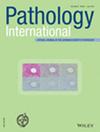航空运输引起的FFPE组织样品中的DNA降解:辐射暴露的实验评估。
IF 3.4
4区 医学
Q2 PATHOLOGY
引用次数: 0
摘要
FFPE癌组织样本的空运导致DNA断裂增加,主要是由于辐射暴露,而不是温度变化或冻融循环。虽然总体降解程度较低,但需要高核酸完整性的关键样品可能受益于局部测试或研究。避免航空运输有助于减轻潜在风险并确保可靠的结果。本文章由计算机程序翻译,如有差异,请以英文原文为准。
DNA Degradation in FFPE Tissue Samples Caused by Air Transport: An Experimental Evaluation of Radiation Exposure.
Air transport of FFPE cancer tissue samples led to increased DNA fragmentation, primarily due to radiation exposure rather than temperature changes or freeze-thaw cycles. While overall degradation was minor, critical samples requiring high nucleic acid integrity may benefit from local testing or research. Avoiding air transport could help mitigate potential risks and ensure reliable results.
求助全文
通过发布文献求助,成功后即可免费获取论文全文。
去求助
来源期刊

Pathology International
医学-病理学
CiteScore
4.50
自引率
4.50%
发文量
102
审稿时长
12 months
期刊介绍:
Pathology International is the official English journal of the Japanese Society of Pathology, publishing articles of excellence in human and experimental pathology. The Journal focuses on the morphological study of the disease process and/or mechanisms. For human pathology, morphological investigation receives priority but manuscripts describing the result of any ancillary methods (cellular, chemical, immunological and molecular biological) that complement the morphology are accepted. Manuscript on experimental pathology that approach pathologenesis or mechanisms of disease processes are expected to report on the data obtained from models using cellular, biochemical, molecular biological, animal, immunological or other methods in conjunction with morphology. Manuscripts that report data on laboratory medicine (clinical pathology) without significant morphological contribution are not accepted.
 求助内容:
求助内容: 应助结果提醒方式:
应助结果提醒方式:


